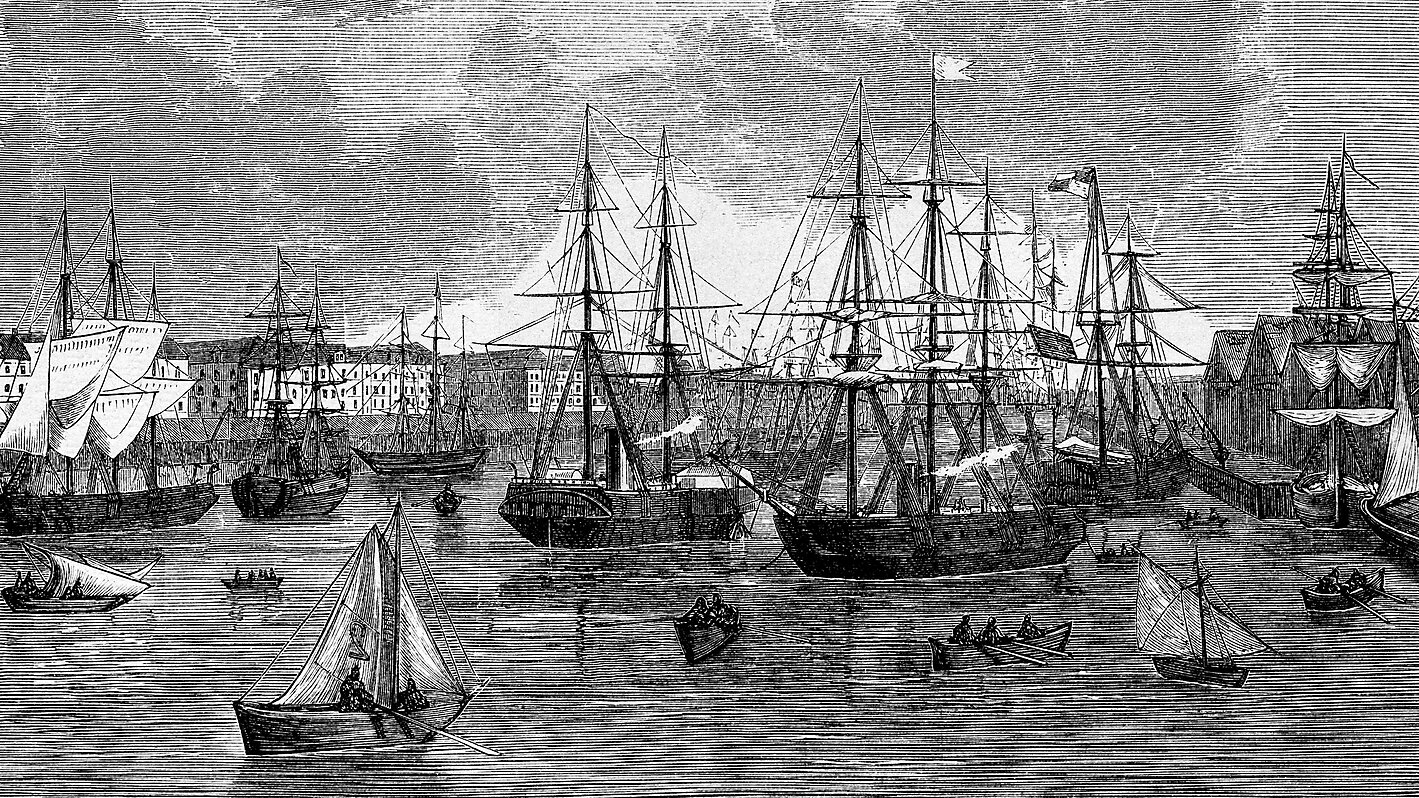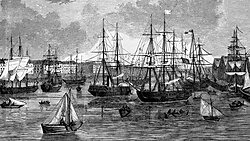To understand the market-integrating potential of these apparently modest gains in shipping productivity, it is useful to look at Canada and the integration of its internal markets between 1760 (after it became entirely a British possession) and 1850. By virtue of Great Britain being a single polity, there were no tariff barriers of relevance between the different colonies of British North America. Yet Canada is geographically immense. The waterway distance between Halifax, Nova Scotia, and Toronto, Ontario, is 4,071 nautical miles—roughly the same as the distance from Bremen, Germany, to Alexandria, Egypt. Ships carrying goods between the different colonies thus had to travel long distances (along riverways rather than the open seas), suggesting the presence of important natural barriers to trade.
However, if we look at trends of market integration from the late 18th century to the mid-19th century, we observe that markets were becoming increasingly integrated. The most common measure of market integration is the coefficient of variation, calculated by taking the standard deviation of the prices across all the different markets and dividing it by the average price across all the different markets. The lower the coefficient, the more integrated markets are. In the 1760s, that coefficient stood north of 0.2. By the 1850s, it had fallen to less than 0.1. This is a strong trend in favor of market integration. If you use the 1831 census data, which cover a cross section of more than 300 areas in the British colony of Quebec (which was larger than half of Europe), you can also get a coefficient of variation that can be compared with those of European nations. The level reported in the 1831 census is between 0.097 and 0.099—a figure that matched the level of market integration observed within Britain at the same time. Because of the absence of trade barriers within the colony, the vast majority of those levels and trends would have been explained by the modest technological advances of the late 18th and early 19th centuries. But remember that we are describing a colony the size of half a continent. This amounts to saying the small gains in shipping productivity were sufficient to drive market integration on a gigantic geographical expanse where no relevant legal barriers to trade existed.
The above example suggests that market integration could have happened easily without government-created trade barriers. We have a further example—again from Canada—that should help reiterate this point. As a colony, Canada had no control over its trade policy. The British Parliament and the Colonial Office in London would decide which tariffs (and to what level) to place in Canada. They could also decide to repeal those tariffs—which is what they unexpectedly did in 1831 with the Colonial Trade Act. In one fell swoop, all tariffs on American agricultural produce were abolished. American foodstuffs could enter Canada freely, an extreme case of unilateral trade liberalization. (The United States did not reciprocate.) Overnight, American wheat and flour flooded Canadian markets. In the colony of Quebec, wheat went from being more than three-quarters of grain production in 1831 (a proportion that had been stable since the 17th century) to less than a tenth in 1844. A colony that had been a net exporter of wheat became a net importer overnight—close to 2.2 million bushels for a population of less than one million. American wheat was so much cheaper that the colonists simply shifted to producing other crops or to other sectors of activity while the consumption of wheat per capita increased 22 percent. Prices of agricultural goods in Canada rapidly began moving in greater synchronicity with American prices. This was an extremely rapid pace of adjustment to trade liberalization. Again, bear in mind that we are now talking about not only Canada but also the American areas along the Great Lakes (Ohio, Michigan, New York, Illinois, Indiana, Wisconsin, and Pennsylvania). This is a huge geographical expanse—as large as Europe—that rapidly integrated once the government barriers to trade were removed.
These instances indicate that the relatively modest shipping productivity growth of the late 18th and early 19th centuries had the potential to surmount considerable natural trade barriers. However, in the latter case, this potential was hindered by governmental trade barriers, specifically the tariffs in place before the enactment of the Colonial Trade Act of 1831. This highlights how government-made regulatory obstacles, in contrast to physical or geographical (i.e., natural) obstacles, played a pivotal role in shaping trade dynamics during the period.
The logic of these examples can be extended further to a far greater geographic area—the entire North Atlantic—because of the pioneering work of Paul Sharp and Jacob Weisdorf. In 2013, they published an article in Explorations in Economic History in which they studied market integration for wheat between the United Kingdom and the United States from 1700 to 1900. Trade volumes for wheat were small between the two nations (and were generally one-way from the colonies to the home country). However, prices for wheat shared important co-movements and there was a clear trend in favor of market integration. If prices in Britain rose beyond a certain threshold, American imports would surge, which would affect prices in both markets. This is essentially stating that the law of one price was operating. What impeded the operation of the law of one price was what Sharp and Weisdorf called “exogenous shocks”—a broad categorization that blends wars, political disintegration, and tariffs. But in practice, these are all policy shocks. Once the United States became independent, the British initially retaliated by blocking access to their markets (and those of the colonies), and they later tightened the Corn Laws (a set of protectionist measures that restricted the entry of grain). The United States also retaliated in multiple ways. These retaliatory measures are in addition to the disturbances caused by wars themselves. As such, between 1800 and 1847 (the period after the tightening of trade barriers between America and Britain), Sharp and Weisdorf find no signs of the law of one price operating. In other words, markets were integrating until the American Revolution and postrevolutionary trade barriers ended the trend.
In their conclusion, Sharp and Weisdorf clearly evoke the possibility that the first age of globalization could have started earlier. They point out that imports of wheat to Britain as a share of total consumption rose significantly after the repeal of the Corn Laws in the late 1840s; an American “grain invasion” then occurred. Sharp and Weisdorf then discuss the multiple merchant petitions during the 1791 debates regarding the tightening of the Corn Laws. All the petitions highlighted the importance of the American wheat trade to Britain’s food supply. Absent wars and tighter policy-related barriers to trade, Sharp and Weisdorf state that “we would now date the grain invasion—and possibly even the origins of globalization—to the late 1700s, rather than a century later.”
This was merely informed speculation at the time of Sharp and Weisdorf’s study. In subsequent work, Sharp, Maja Pedersen, and I decided to tighten that case by—yet again—looking to Canada. There are three reasons for this. First, Canada had a small population. Its influence on world prices was minimal. Thus, if there was strong market integration, we should expect that prices there would have responded strongly to price changes abroad. Second, Canada became entirely British in 1760. Until 1783, it was part of a large “free trade zone” in wheat with Britain and the United States. However, after 1783, Canada remained a British possession. Each time Britain tightened trade policy, preferential treatments were carved out for Canadian producers by virtue of being members of the British Empire. Third, Canada shares highly similar geographical constraints (i.e., the span of the Atlantic Ocean) with the United States when the time comes to access British markets. The preferential treatment extended to Canadian producers, who shared similar natural barriers with the Americans, thus allows us to triangulate the relative importance of trade barriers.
We ended up confirming much of the story initially told by Sharp and Weisdorf. Canadian prices responded strongly to American prices before 1783 and strongly to changes to British prices after 1783. In a way, Canada provides a sort of counterfactual. Had the United States still enjoyed the same access to British markets as before the American Revolution, it could have been as well connected as Canada was. The difference is that Canada was so small (less than 300,000 persons by 1800, compared to 5.3 million in the US), it could hardly provide the quantities sufficient to speak of a wheat invasion. Yet on a per capita basis, Canada ended up supplying extremely large quantities. Before the American Revolution, when the Canadian population was less than 100,000, between two and six bushels per person were exported annually. Until the 1830s, generally more than one bushel per person was exported (with the exception of years with export bans due to crop failures or wars blocking ports). Had Americans supplied a similar effort on a per capita basis as the Canadians, that would have been the grain invasion of the 1840s. Bear in mind that this is not free trade. This enormous Canadian effort was achieved only with a lesser degree of discrimination against Canadian imports into Britain—a strong case for saying that policy barriers delayed globalization.
Unsatisfied by this evidence, I decided to address one last limitation of the work of Sharp and Weisdorf and the work I did with Pedersen and Sharp. Both studies used annual wheat prices. This is low frequency and makes it hard to assess price adjustments in the shorter run. As such, I teamed up with Antoine Noël to circumvent this limitation by collecting monthly wheat prices for three American cities, London, and Quebec City. We compared the coefficients of variation (i.e., the measure of market integration described earlier) from the 1760–1775 period to those of the post-1783 period, when governments erected more barriers to trade. In Figure 1 below, we show the results of this comparison. The dashed red line shows the coefficient of variation between Canada and the United States over the entire post-1783 period. The black line shows the monthly coefficients of variation during the pre-1775 period. With the exception of the first months after the Conquest of 1760, markets were always better integrated before 1775. In the 1760s and 1770s, despite less advanced transportation technologies and the absence of significant trade policy barriers, Canada and the United States enjoyed a stronger connectedness than they would in the 1840s, when more advanced transportation existed but was hampered by major trade policy obstacles. In fact, levels like those observed in the 1760s and 1770s would not be seen again until Canada and the United States signed the Treaty of Reciprocity in 1854.















